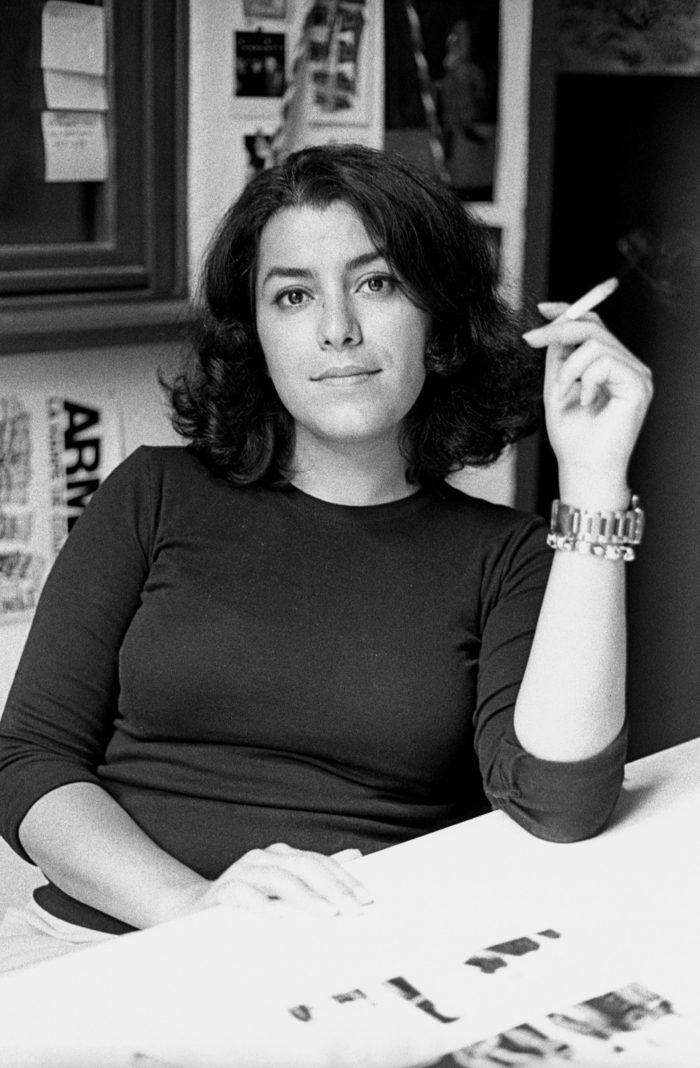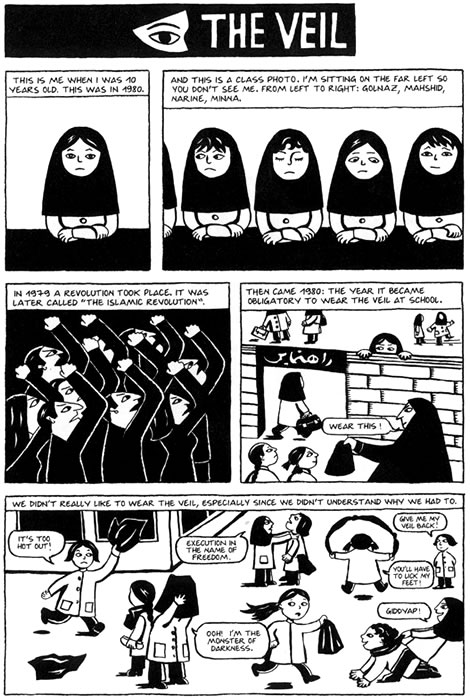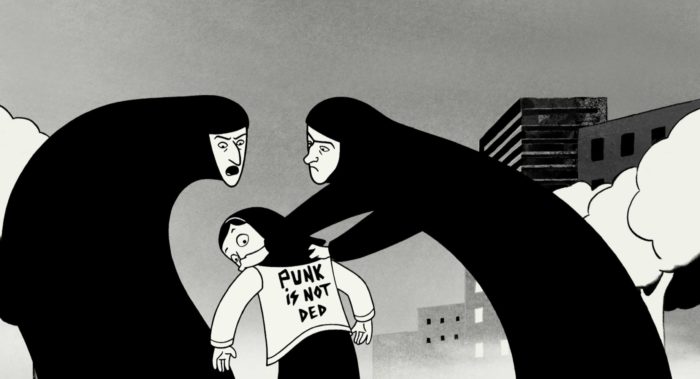By Sabiha Tafader
Persepolis, by Marjane Satrapi, is the autobiographical story of the author, a young woman who was born in Iran in 1980, when the Islamic Revolution had already begun. She grows up in a time of wars between Iraq and Iran, unstable periods in which major political changes were also taking place. Telling her story with the vivid words and pictures of a graphic novel (which was later released worldwide as an animated film) Satrapi recalls experiences of oppression in her country that leads her to contemplate challenges faced from childhood to adulthood in her life because of the laws enforced by the Islamic regime. In this graphic novel, symbolism is used to illustrate how the “the veil”, “the cigarette”, and specific books affect her perspective on her life in either positive or negative ways.
In Satrapi’s view, the veil symbolizes oppression and limitation, which prevents Marjane from expressing herself. She states, “Then came 1980: the year it became obligatory to wear the veil at school.” This directly alludes to how the veil is shown as an oppressive device for the girls, especially since they had no choice but to wear the veil in school.
“I really didn’t know what to think about the veil.” Writes Satrapi. “Deep down I was very religious, but as a family we were avant-garde.” Furthermore, as shown in the 5th panel of page 76, a “scarf of beating” , both reveals and illustrates that even though Marjane goes through internal conflict because she feels that she is religious, she is modern as well because she indirectly views the veil negatively.
This perspective aids her in understanding the violence used to maintain the Islamic regime’s rule—and the seriousness of rebelling—which until then she had seen in a negative light. She states simply, “I wanted to be an educated, liberated woman…”
Later while narrating another scene she expresses this desire again with the words: “I needed to learn to become a liberated and emancipated woman.” These rebellious feelings show how Marjane’s true identity was concealed by the obligatory veil. Inasmuch as the veil was mandatory to wear in school and most public places, it gets in the way and makes it difficult for her to achieve her dreams. This affects her negatively on the way she views her future life.
The books Marjane read in those years were a symbol of her curiosity about various wars in her country. These books motivated her to learn about historical events, and to understand herself. She proudly states in one illustrated panel:
“I knew everything about the revolutionaries of my country, Dr.Fatemi 1928-58.” This tells us that by reading books, Marjane is able to educate herself. This affects her positively because even in the midst of political oppression and her own internal conflicts, she has the motivation to learn about the the origins of all this confusion. As expressed by her character on the last panel, “I realized then that I don’t understand anything. I read all the books I could.”
Clearly Marjane has the motivation to become educated. But beyond this, she also developed a great passion for her country’s well-being which is why she was determined to read particular books. Her character admits on page 175: “To educate myself, I need to understand everything. So, I threw myself into reading.” This showed how Marjane had started to mature. She understands that for her to be educated, she needs to rely on herself, and to teach herself the things that she wants to know.
The cigarette, and smoking in general, is used in this book to symbolize coming of age. Throughout the graphic novel, at several points, Marjane expresses her feelings about the ongoing wars in her country. In one scene she explains that: “Those who opposed the regime were systematically arrested. With this first cigarette I kissed my childhood goodbye.” Marjane is annoyed—almost angered—by all the strict government rules, and so she smokes to show her rebellion. Because smoking is forbidden in Iran, this becomes her favorite way of showing her opposition towards the laws of this new regime.
However, because she is still struggling to live a normal life within her family, she has to always be cautious and aware of her surroundings. For instance, she clearly describes on page 302 the paranoia instilled by strict rules around dress and behavior : “…one person leaving her house while asking herself…is my veil in place? …can my makeup be seen?”
This conveys what it is like being in a country where one can’t really do certain things in public, and how this restricts one’s sense of personal freedom. By smoking, Marjane feels that she can let go of her childhood and feel grown up and independent; even though in reality it’s not true.
As a whole, the book captures how Marjane’s life and personality was shaped due to the Islamic regime that motivated her to read and learn more about her country.
As a way of organizing her story into meaningful sections, the symbolism of the “veil”, the “cigarette”, and “books”, aids us in comprehending Marjane’s character as her drawings and dialogue detail her actions and feelings throughout the events described in the novel.
Works Cited
Satrapi, Marjane. The Complete Persepolis. St. Albert, AB: SAPL, 2013. Print.


